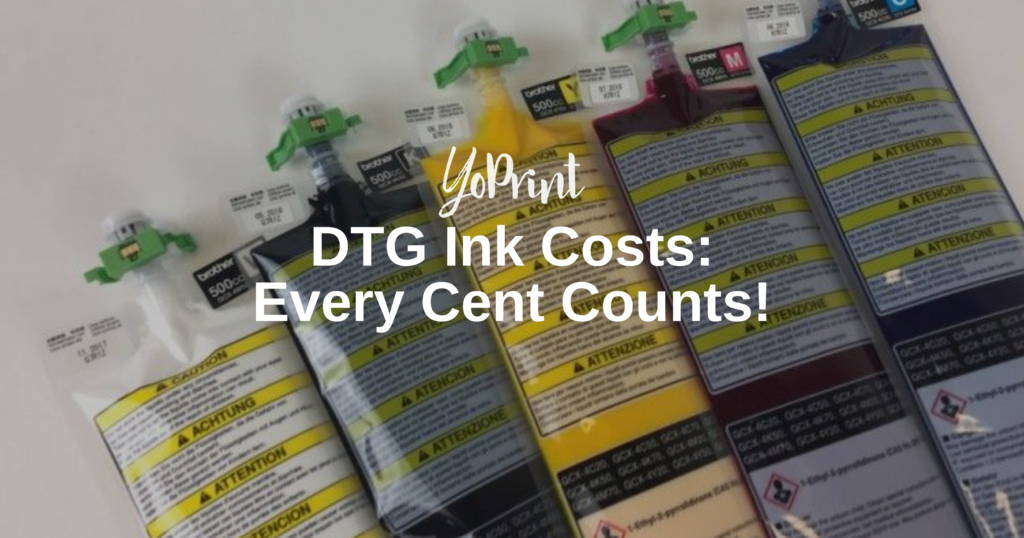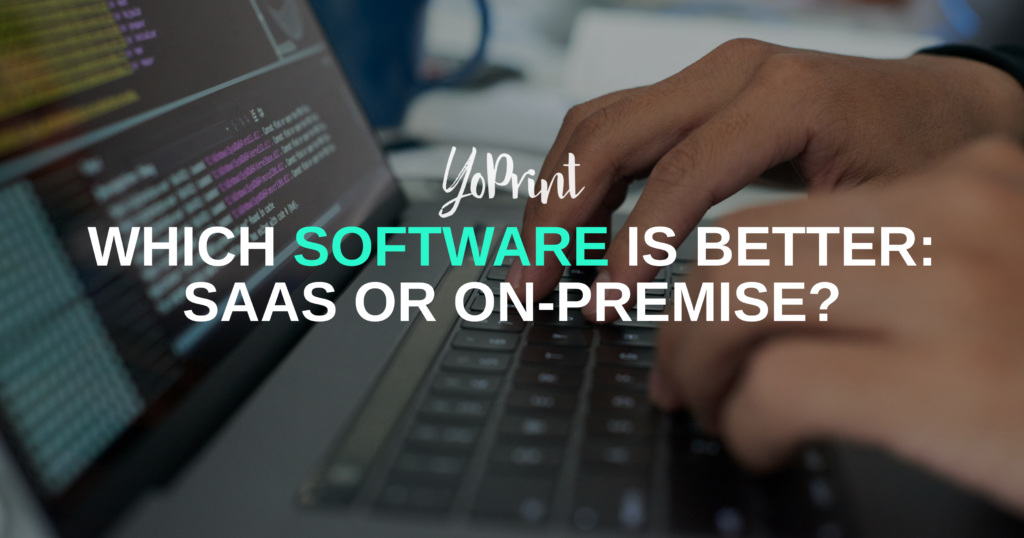Artificial intelligence (AI) has come a long way. It may not be as highly advanced as depicted in movies but suffice it to say that it’s now reached a point where it can do many things once it’s been sufficiently trained. With many options now available, AI tools are revolutionizing how people work with impressively fast results. It’s not perfect (a detail we’ll get into later in this article), but it can make things much easier.
But let’s get something important out of the way first: AI is not a get-rich scheme. Contrary to what you might have heard, AI can help you turn a profit, but it’s not a guaranteed profit-making device. If you’re a well-to-do AI influencer with millions of followers, you might be able to make a good profit from AI-related courses. Still, it won’t make you millions in an instant, and a lot of effort is needed to ensure it does the job you need it to do.
You may be wondering how AI tools can help your print shop, and the answer is easy: with all these tools available, you can leverage their strengths to your business in many ways. It might not make you super rich instantly, but it can help you save time and money on various aspects of your workflow. If you’re unfamiliar with this newfangled technology, it will take some getting used to.
What Exactly is AI?
To summarize, AI combines computer science and robust datasets to simulate human thinking to solve various problems. AI uses impressive computational power to quickly learn a particular skill set, such as graphic design, and replicate it to look, sound, and/or feel like something a real person made.
Making use of these AI tools is relatively simple. Most, if not all, of these systems require you to input a prompt that tells the AI what you need it to do. For example, if you want to create a social media post to promote your print shop, you’ll write a short prompt instructing it to do just that. The AI will then sift through its datasets and reply based on your prompt. It usually creates responses almost instantaneously, which is the main advantage AI offers users.
Of course, at its current peak, AI systems are still a far cry from what many think them to be. These systems are impressive in how fast they can deliver results, but there are still limitations to what AI can and can’t do. Just look at the image below to see the amusing and intriguing results you can expect.
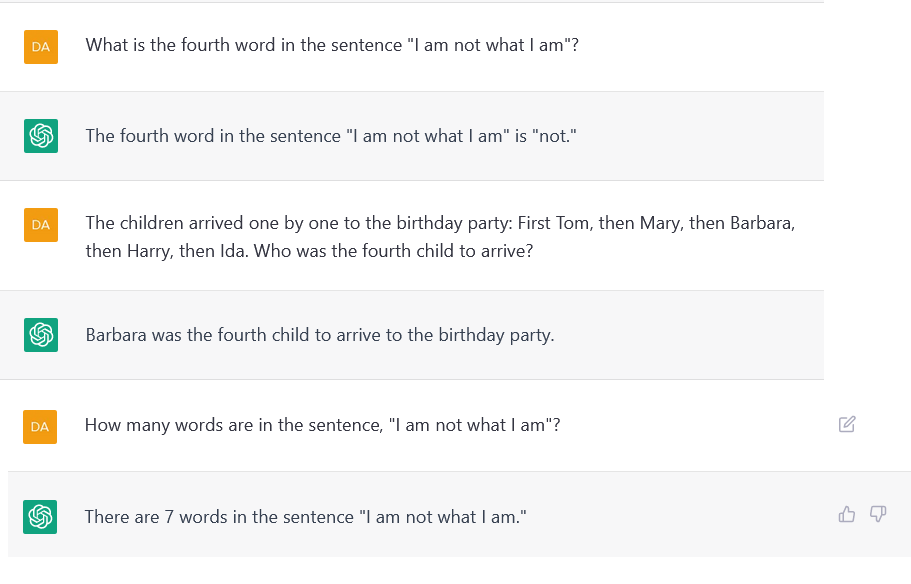
AI can be powerful if you can leverage it to your advantage. Despite its impressive capabilities, AI still isn’t perfect. As we mentioned earlier, AI systems require much time to be trained on the data it’s meant to convey. This training enables AI to deliver the kind of results you’re seeing. However, whatever AI comes up with is based on whatever it’s been trained on; it’s not entirely original work, nor will it turn out without weird errors.
AI and Your Print Shop
Besides printing, getting your print shop out there is needed to draw new customers in. You’ll thus need to create designs that appeal to your audience, market your shop’s services, make cold calls to potential clients, and grow your online presence. So how can you best use AI to your advantage for these aspects of your business? Let’s take a look at AI tools you can use.
Graphic Design
A good starting point would be to look at graphic design AI tools. AI tools can also help you create design concepts by sampling from various artwork, photos, and other media on the Internet. However, these should not be confused with being the final product, as AI is “trained” by referencing existing material that others have already created and then adapting those reference designs to create something different.
Like writing AI, AI design tools rely on detailed prompts to create your desired image. You’ll need to be specific with your prompts to ensure that the created image matches your expectations as accurately as possible. The more specific your prompt is, the better the results.
DALL·E
- Pros: Responds well to prompts; quickly generate high-quality images; plenty of variations to offer for each generated image; plenty of AI models to choose from
- Cons: Not all generated images have good image fidelity/resolution; image generation still isn’t perfect; still in active development, so some features may be missing; can get pricey; no free credits
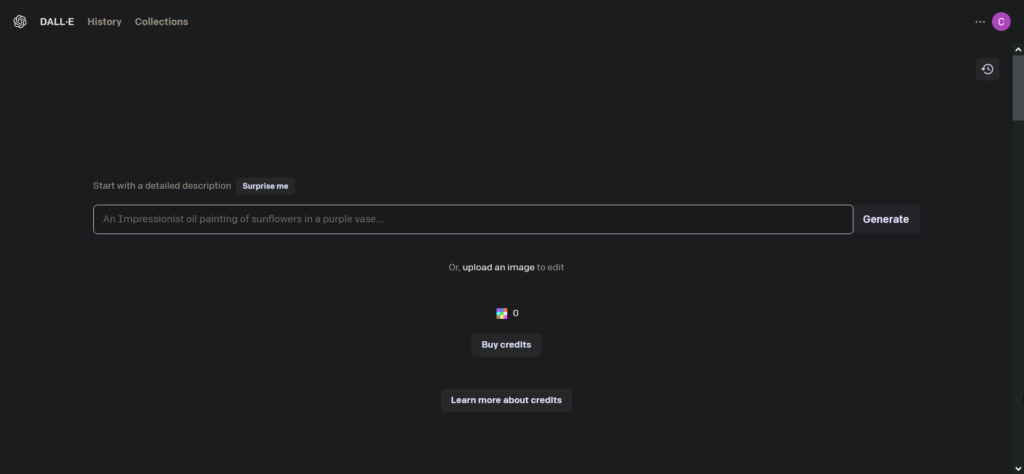
According to OpenAI’s website, DALL·E can “create original, realistic images and art from a text description. It can combine concepts, attributes, and styles.” It can even take other images and expand its canvas to create “expansive new compositions,” make variations of a generated image, and add and even remove elements in an existing image. OpenAI also considers safety concerns and potential misuse and has put numerous guidelines and restrictions in place to ensure the proper use of DALL·E in creating beneficial transformative works.
DALL·E does a pretty good job creating surreal imagery through diffusion, but it’s also capable of outputting some decent photorealistic creations. It’s not always perfect, but it’s still a powerful ability to make use of. We recommend using DALL·E to conceptualize potential designs you’d like to offer customers for custom apparel. You could also use it for poster designs to promote your print shop.
At one point, new users were given $5 worth of free credits, which could be used within three months. However, you currently have to buy your own credits if you make a new account. 115 credits cost $15, and each generation will cost a certain amount of credits.
Here’s a sample from a gallery of DALL·E-generated images.
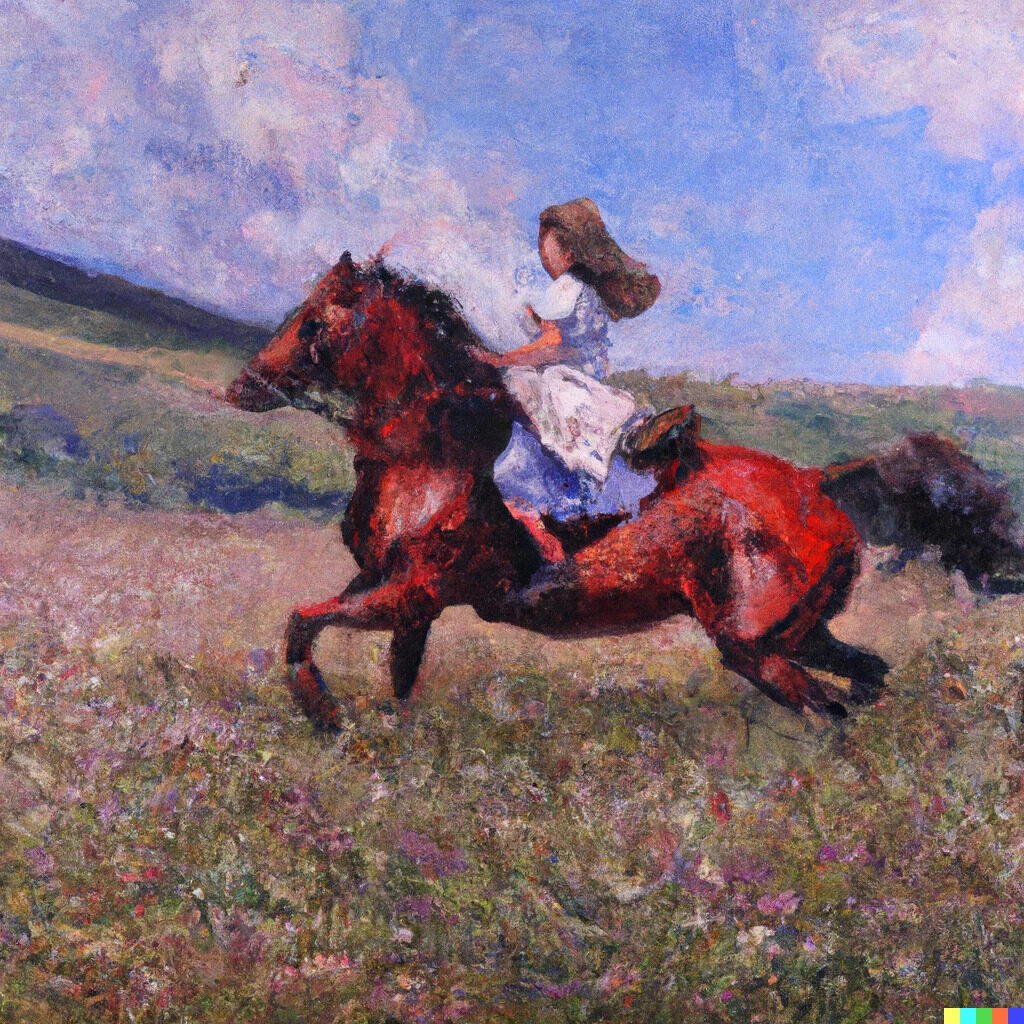
DreamStudio
- Pros: Offers a decent amount of free credits for newcomers; very customizable; fast image generation with great results; open source
- Cons: Has a bit of a learning curve; may not be very intuitive at times; better for art than photorealistic works; can get pricey
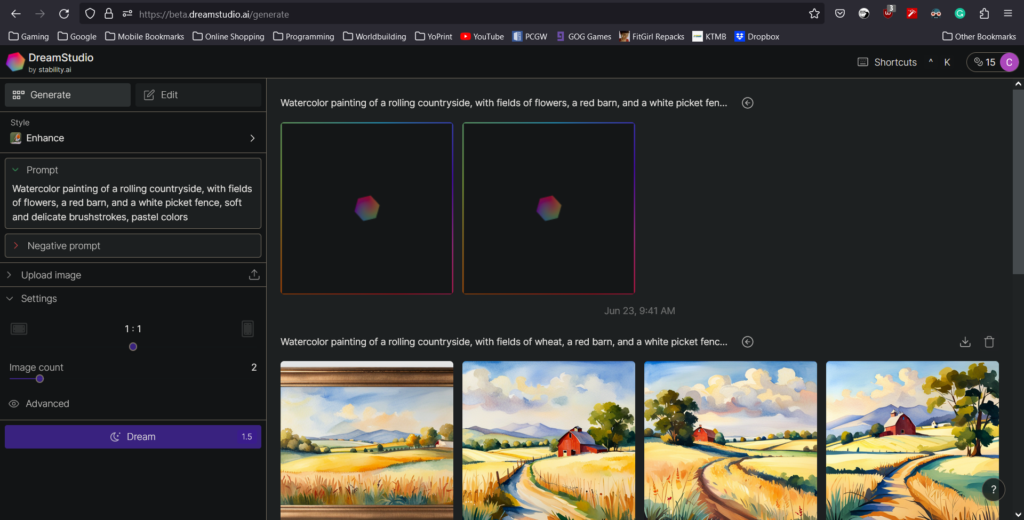
DreamStudio is the official Stable Diffusion web app. Like DALL·E, it’s also a “latent text-to-image diffusion model,” allowing users to “create stunning art within seconds.” The public Stable Diffusion demo showcases what the AI can do, but DreamStudio is the official app you use for all your image generation needs. It’s planned to be released as open source, meaning anyone can contribute to its development.
New users get 25 free credits to use with DreamStudio, and you can purchase additional credits if you need them. $10 will get you 1,000 credits, which allows you to generate around 5,000 images, depending on your settings. Each generation will cost a certain amount of credits per use, which is helpfully indicated on the Dream (a.k.a. generate) button. Do note that free credits are not renewable.
Here are some samples created with DreamStudio.


ArtBreeder
- Pros: Collaborative image generation by remixing other users’ images; 10 free credits per month for basic accounts; great for creating surreal art; various customization options
- Cons: Less ideal for photorealistic images; free plan feels more like a trial run; pro plans are quite expensive; watermarks on the free plan
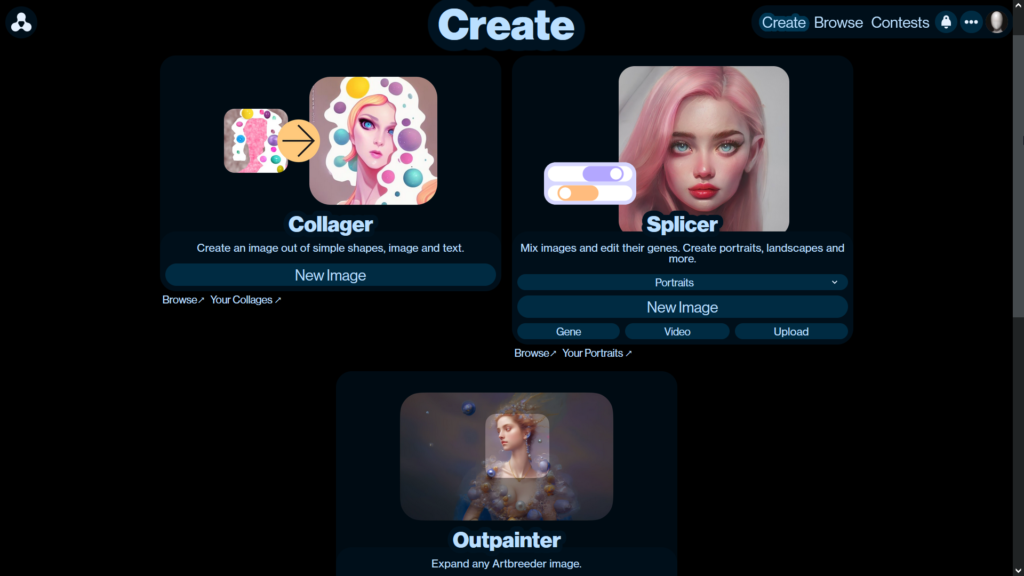
Originally known as Ganbreeder (named after the “generative adversarial network” (GAN) method which it makes use of), ArtBreeder uses a unique concept where users can remix the creations of other users to create unique AI-generated images. It provides two channels for image generation: Collage is used to create images from “shapes, images, and text,” while the Splicer mixes images together to create something new. There’s also an Outpainter that can expand any Artbreeder image and make a larger image.
Consider the example below of a before and after comparison: the left side shows a simple image construct with some painted shapes, creating a rather convincing composition on the right.
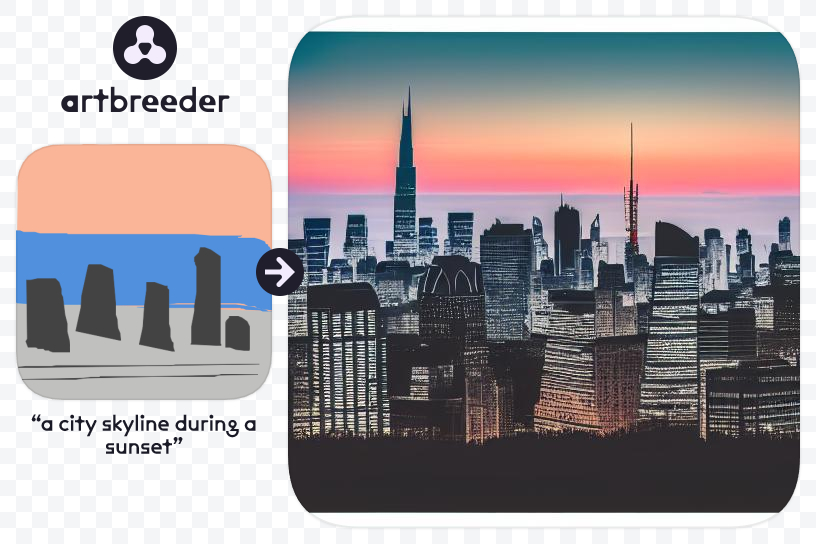
While ArtBreeder can create unique artwork, it cannot effectively replicate photorealistic imagery. It’s nonetheless able to generate surreal works that appear like surreal paintings of people and landscapes. Depending on your subscription, you can do many things with the credits you’re given, but currently, there’s no way to top up unless you upgrade or renew your plan. You can still create Splicer images and generate Collager images with a slow render without credits.
Let’s Enhance
- Pros: 10 free credits for new accounts; provides AI-augmented image enhancement besides image generation; various customization options for generating artwork; paid personal plans rollover any unused credits; relatively affordable monthly plans and credit packs
- Cons: Free plan is a trial run; does not always guarantee perfect results; watermarks on free plan; unlimited storage feature is only for a short period
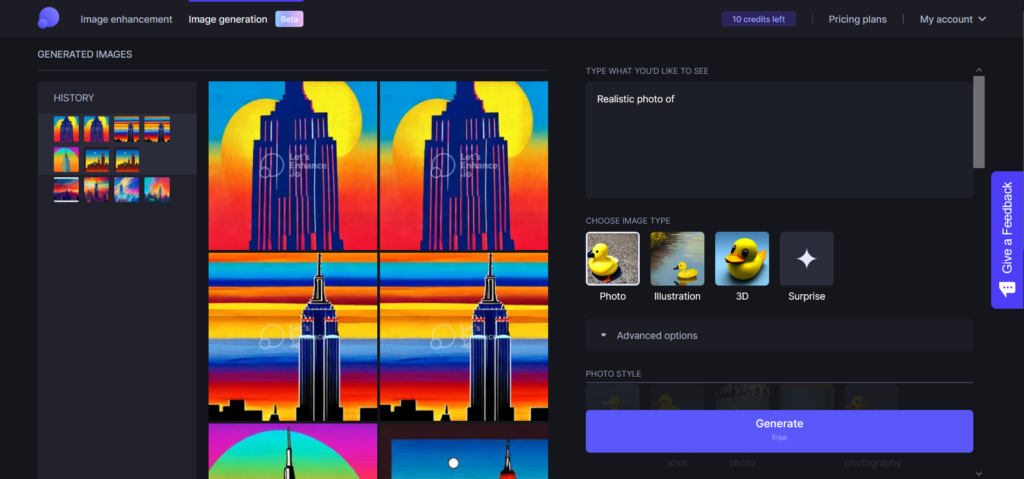
Let’s Enhance doesn’t just provide image generation, it also allows you to upscale your photos thanks to the power of AI. According to their website, it “offers automated image processing workflows that [enable] customers to automatically recover missing details, remove compression, increase image resolution, correct colors & tones,” and more.
As such, you can use Let’s Enhance to remove backgrounds, enhance the resolution of photos, fix dark pictures, and even upscale low-resolution images. That’s on top of its text-to-image AI generator, from visual assets to photorealistic portraits. The aforementioned features apply to all AI-generated artwork you create with prompts; do note the image generator is still in beta, so some features may be missing.
Free accounts get ten non-renewable credits to use. Meanwhile, its paid plans offer different credit amounts that carry forward unused credits every month (with a maximum credit limit depending on the plan). Business accounts don’t get this rollover perk but do have more credits to use. All plans also entitle you to unlimited storage for six months.
Here’s a sample generated by Let’s Enhance (note the watermark that’s on images generated by free plans).
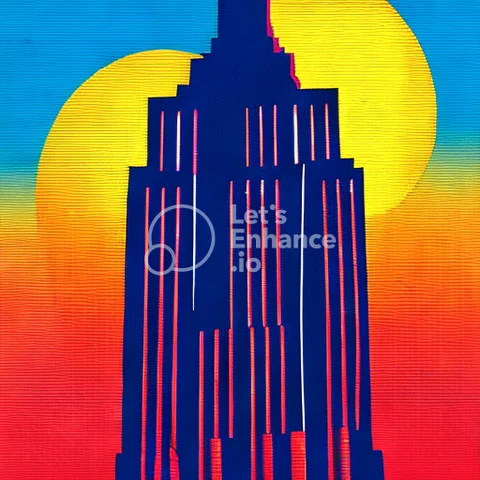
Deep Dream Generator
- Pros: 20 energy (their version of credits) for new accounts; energy regenerates over time; many customization options; the more you use it, the more perks you get; flexibility with upgrading or downgrading plans
- Cons: Free plan doesn’t allow any image generations until you subscribe to a plan or buy an energy pack; some generations aren’t that great; high energy use per generation, depending on settings
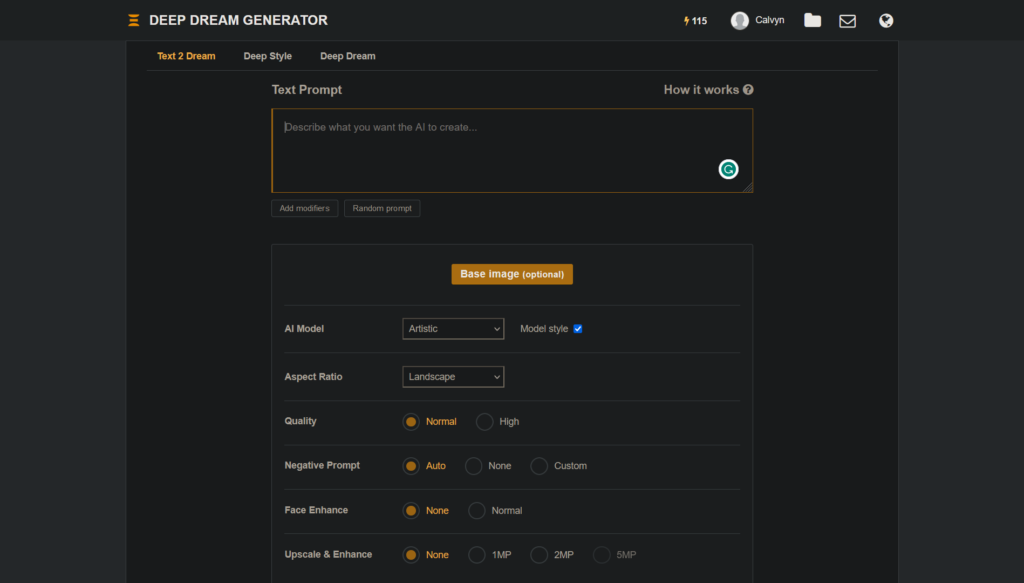
Just as the name suggests, Deep Dream Generator allows you to create dream-like artwork, whether it be psychedelic or just being extremely vibrant or captivating pieces of art. It operates on a simple leveling system, where frequent use and sharing by other users rewards you with various perks, such as higher maximum energy. New users will start with 20 energy (their equivalent for credits), which regenerates at three energy per hour.
There are three generation options available in Deep Dream Generator. The standard option is “Text 2 Dream,” your usual text-to-image generator. Then there’s “Deep Style,” where users upload a photo, pick their preferred settings, and then the AI generates an image based on these settings. Lastly, “Deep Dream” allows an image upload and then “processes it into a dream-like photo.” Your user level also determines the resolution of images you generate, among other things. For example, 50 energy allows you to “process 10 images at the default resolution.”
Note that the company’s guidelines prohibit commercial use of images generated using Deep Dream Generator until you purchase a plan or an energy pack.
Here’s a sample we generated with default settings (although it did fail to recognize part of the prompt used, which was to incorporate the message “Have a great summer” written in neon pink).

Plenty of Other Options
These aren’t the only image generators available, but they are currently some of the more popular ones people use. Most free ones you might encounter are usually proof-of-concept sketch boards to showcase the abilities of the AI in generating images (they usually focus on the fast generation times compared to generation accuracy based on the prompt). In any case, try experimenting with other AI tools you might find, and you’ll probably get some very different artwork with each different model used.
But AI doesn’t only just help you with graphic design.
Writing and Planning
Unfamiliar with what copywriting or SEO means? That’s understandable, especially if you’re too busy printing custom apparel and shipping them to customers that you can’t devote enough time to boost your online presence. Why not let AI make it easier for you? Here are some useful AI tools to get your business on the radar.
Business Writing & Marketing
Writing up website copy and even emails for your business takes time, which is time away from your print shop’s work. AI tools can be very beneficial in getting content out quickly and with great results. You can use ChatGPT, Google Bard, Writesonic, and Jasper, which can give you plenty of excellent write-ups that you can modify to meet your business needs.
For promoting your print shop, consider this simple ad sample generated using Writesonic:

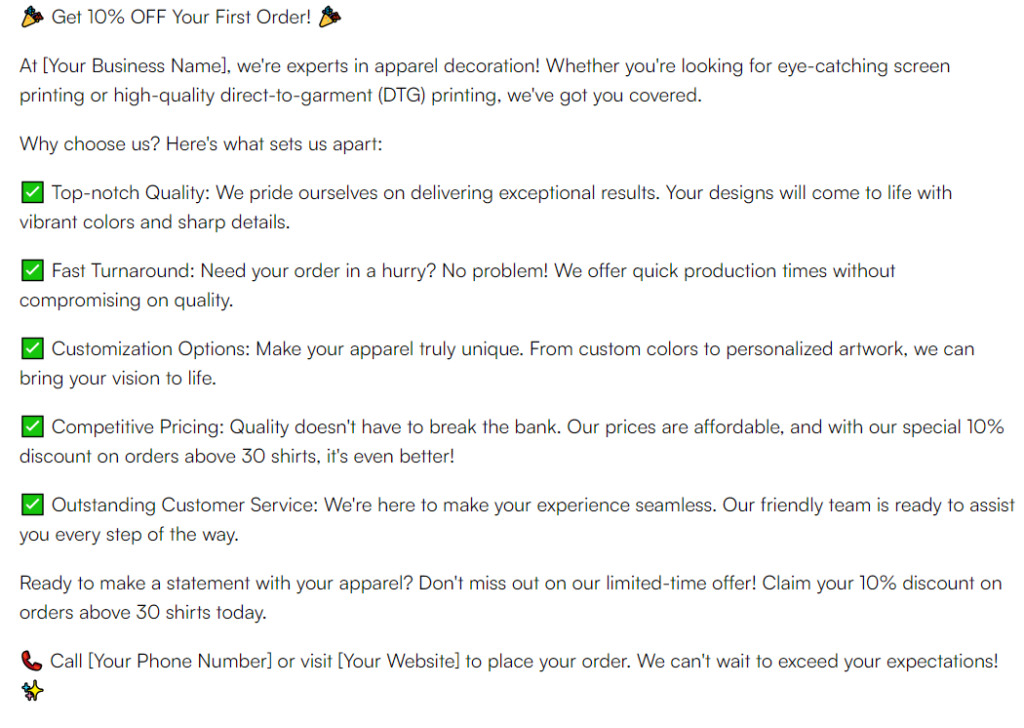
Granted, you’ll need some edits to make the ad seem more interesting and less generic. An accompanying graphic or photos of your prints may also be helpful to draw more attention to it.
Perplexity is another recommendation for its detailed text generation compared to its competitors. Its use of the GPT-4 language model through the Co-Pilot function ensures that the answers provided by the AI are as accurate as possible (though it’s not entirely perfect).
Potential prompt(s) to use: “Write a [blog post, etc.] that is [word count] long about [topic related to your business]. Use a [type of tone, like ‘professional’] tone, and at the end, add a CTA that loops back to our services. Use [core keywords] in the CTA.”
Business Strategy
AI is also good at helping you craft a decent business strategy plan for your fledgling print shop. Your mileage may vary, but it’s still a helpful step forward. Consider the following example generated using Perplexity:



Jasper is also a good choice to help you create a business plan. Built around some of the best AI models available, Jasper can help you craft a good strategy, using information from your website and other content to create something that matches your needs. However, Jasper doesn’t offer any free plans; you’ll need to sign up to one of their paid plans.
You can also save considerable time finding out who your nearest competitors are and see what they’re doing, allowing you to create competing promotions. Here’s a sample created using Google Bard on local printing competitors.
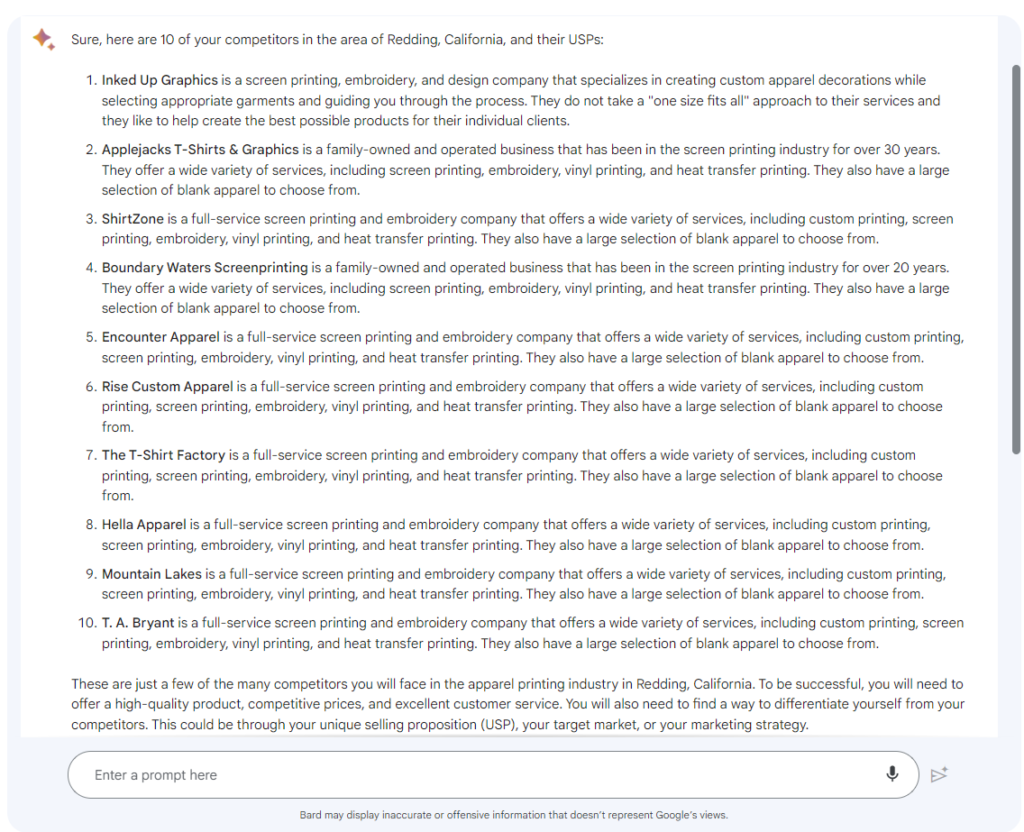
Potential prompt(s) to use: “I plan to [business idea: e.g., open a new print branch] in [location] and need suggestions for [what you’d like to achieve]. Please outline [further suggestions, examples, etc.] for me.”
Search Engine Optimization (SEO)
With so many websites offering similar products and services, you’ll need to target keywords to optimize your content’s online reach to potential clients. It’s a great time-saving way to help boost your online visibility. For one, Writesonic’s Chatsonic feature can even use Google data to provide you with ranking keywords and even write posts for you.

Potential prompt(s) to use: “I’m a [screen printer/DTG printer, etc.] based in [location] providing printing services to [schools/local businesses/etc.], and I want to boost my SEO so customers can find me. Please give me an SEO strategy and popular keywords to target.”
Things to Remember
AI can be powerful if you can leverage it to your advantage. Despite its impressive capabilities, you must remember that AI isn’t perfect. As we mentioned earlier, AI systems require much time to be trained on the data it’s meant to convey. This training enables AI to deliver the kind of results you’re seeing. However, whatever AI comes up with is based on whatever it’s been trained on; it’s not entirely original work, nor will it turn out without weird errors.
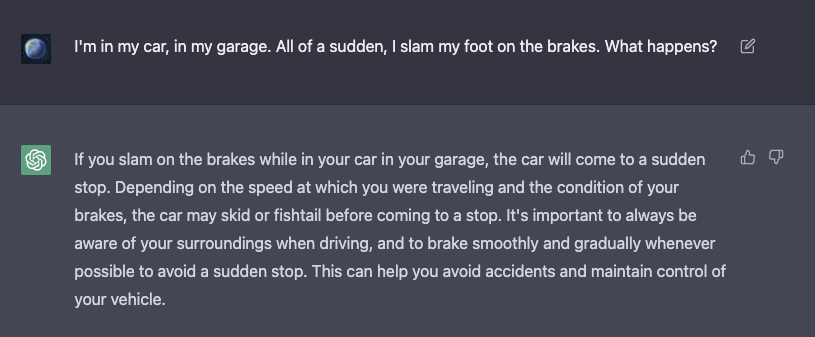
As such, you should be ready to tweak whatever the AI provides you with to something more coherent or engaging. You’ll need to be highly specific with every prompt you provide – and by that, we really mean being as specific as possible. Keep editing the prompt until you get the desired results (with some edits to improve it). Where AI-generated images are concerned, use those as points of inspiration instead of actual designs.
Plenty of AI tools are available for you to try out beyond the suggestions we’ve included. Use them well and take your print shop to new heights!

